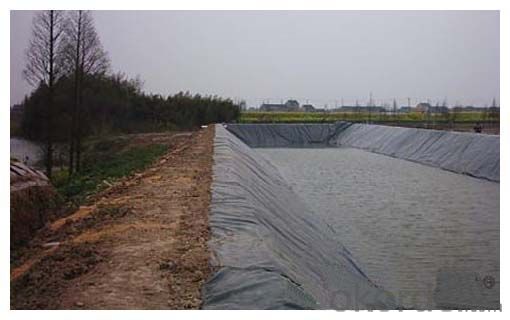- Understanding the Role of Geomembrane Liners in Waste Management
- Innovations in Geomembrane Liners for Water Management
- Geomembrane Liners: A Comprehensive Guide
- The Future of Geomembrane Liners in Civil Engineering
- Geomembrane Liners: Enhancing Landfill Stability
Manager:
WhatsApp:+86 177 0135 2670
Tel:+86 177 0135 2670
Email:marketing@okorder.com
Address:3rd Floor, No.2 Building, No.1 Sanlihe Road
HDPE Geomembranes: The Solution for Ponds in Soil Erosion Control
Ponds, those serene bodies of water that we often find in gardens, parks, or even our own backyards, are not just aesthetically pleasing but also serve various ecological and environmental functions. However, creating and maintaining a pond can be challenging, especially when it comes to soil erosion control. That's where hdpe Geomembranes come into play, offering a practical and efficient solution to this problem.

The Beauty of Ponds and the Beast of Erosion
Ponds are havens for biodiversity, providing habitats for aquatic plants, fish, and various species of birds and insects. They also play a role in water purification, flood control, and even climate regulation. But the beauty of ponds can be threatened by the beast of soil erosion, which can lead to the loss of valuable topsoil, the degradation of water quality, and the disruption of the pond's ecosystem.
Enter HDPE Geomembranes: The Knight in Shining Armor
HDPE, or High-Density Polyethylene, geomembranes are synthetic materials that have gained popularity in the construction and landscaping industry due to their durability, flexibility, and resistance to chemicals, ultraviolet radiation, and temperature changes. They are the knight in shining armor for your pond, protecting it from the relentless onslaught of soil erosion.
Why HDPE Geomembranes are the Heroes of Soil Erosion Control
1. Durability: HDPE geomembranes are made to last, with a lifespan that can extend for decades. This means you won't have to worry about frequent replacements or repairs, saving you time, effort, and money.
2. Puncture Resistance: These geomembranes are tough and can withstand the pressure from soil and other materials, reducing the risk of punctures that could compromise the integrity of your pond.
3. Chemical Resistance: Ponds can be exposed to various chemicals, either naturally occurring or from external sources. HDPE geomembranes are not affected by these chemicals, ensuring the long-term stability of your pond's environment.
4. UV Resistance: The sun's rays can be harsh, but HDPE geomembranes stand up to UV radiation, maintaining their effectiveness even under constant exposure.
5. Temperature Tolerance: Whether it's a hot summer day or a freezing winter night, HDPE geomembranes can handle the temperature fluctuations without losing their properties.
6. Environmental Benefits: Besides their practical benefits, HDPE geomembranes are also environmentally friendly. They are recyclable and have a lower carbon footprint compared to other materials, making them a green choice for your pond project.
How to Integrate HDPE Geomembranes into Your Pond Project
Integrating HDPE geomembranes into your pond project is a straightforward process that involves a few key steps:
1. Assess the Site: Evaluate the area where the pond will be located, considering factors such as soil type, water flow, and the potential for erosion.
2. Design the Pond: Plan the shape, size, and depth of your pond, as well as the location of any features like waterfalls or islands.
3. Prepare the Ground: Clear the site of debris and level the ground to create a stable base for the geomembrane.
4. Install the HDPE Geomembrane: Roll out the geomembrane, ensuring it covers the entire pond area and overlaps with itself for added strength. Secure it in place with anchors or weights.
5. Seal the Seams: Use specialized techniques to join the edges of the geomembrane together, creating a seamless barrier against erosion.
6. Add the Final Touches: Once the geomembrane is in place, you can proceed with adding soil, plants, and water to complete your pond.
The Emotional Connection: Why We Care About Ponds and Soil Erosion Control
Ponds are more than just water features; they are living ecosystems that connect us to nature. The emotional connection we feel towards ponds is deeply rooted in our desire to preserve and protect the environment. By using HDPE geomembranes, we are not only solving a practical problem but also expressing our care for the natural world.
The Future of Ponds with HDPE Geomembranes
As we look to the future, the use of HDPE geomembranes in pond construction and soil erosion control is likely to increase. With growing environmental concerns and the need for sustainable solutions, these geomembranes offer a promising path forward. They are a testament to human ingenuity and our commitment to living in harmony with nature.
In conclusion, HDPE geomembranes are a powerful ally in the battle against soil erosion, ensuring that ponds can continue to be the beautiful, thriving ecosystems we know and love. By embracing this technology, we can create a future where ponds are protected, and their ecological value is preserved for generations to come.
- Previous:HDPE Geomembranes: The Essential Tool for Pond Construction Professionals
- Next:HDPE Geomembranes: The Choice for Ponds in Environmental Protection






